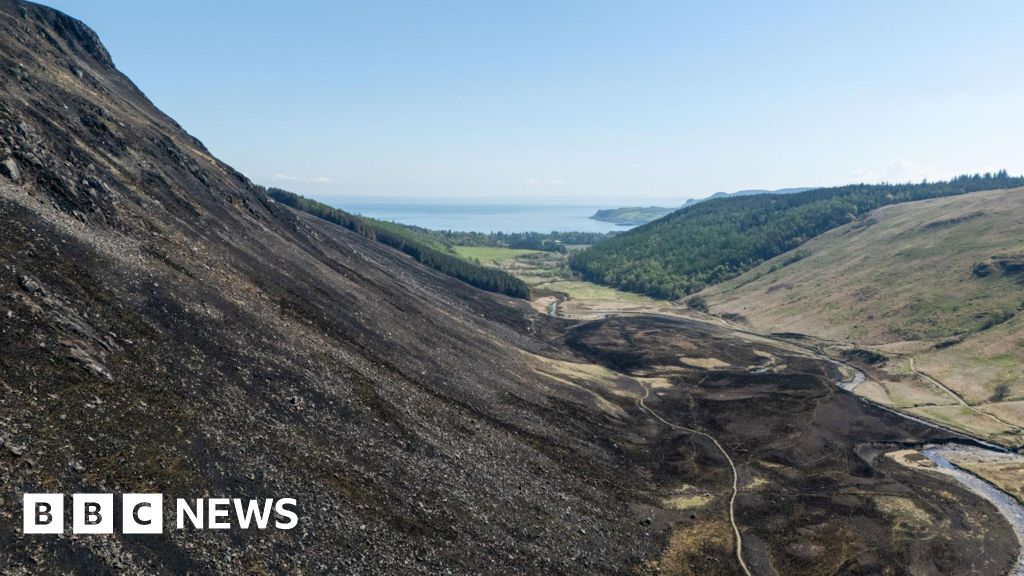BBC Scotland News
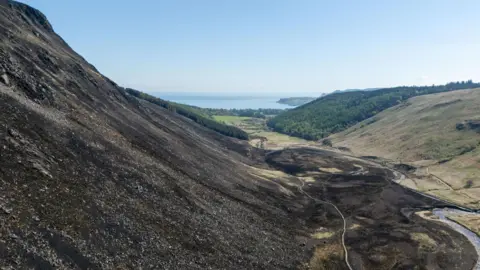 BBC
BBCFor years, conservationists have been working to bring native trees back to the spectacular Glen Rosa on the Isle of Arran.
But a decade of effort was wiped out in days when a wildfire ripped across the valley earlier this month.
“It was years of our work going up in flames,” Kate Sampson, the National Trust for Scotland’s senior ranger on Arran, told BBC Scotland News.
“We just have to start again.
“We’ve lost 10 years of conservation work and effort but we just have to pick ourselves up.”
 Police Scotland
Police ScotlandThe blaze began on Thursday 10 April and was not fully extinguished until the following Sunday.
By the time the fire was out it had destroyed 27,000 trees as well as killing hundreds of reptiles.
Much of the Glen Rosa valley was left looking like a charred and blackened moonscape, with little sign of the years of work from the National Trust for Scotland, which is responsible for the area.
According to the trust, thousands of years ago the glen would have been a native woodland but it was left bare by human intervention such as grazing sheep and deer.
It has been trying to restore the woodlands by introducing downy birch, sessile oak, hazel, willow, aspen and alder as well as endangered tree species such as Arran whitebeam.
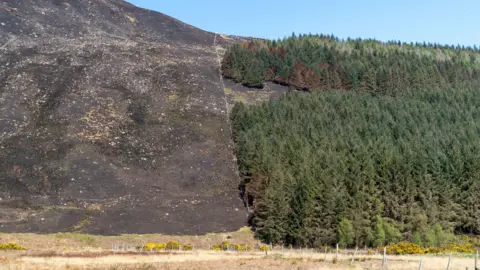
Then, two weeks ago, Ms Sampson could do nothing but watch as years of effort were destroyed.
She was at the scene within minutes of the blaze starting on grassland at the bottom of the valley.
“It was shooting up the hill really fast because of the dry conditions and the wind,” she told BBC Scotland News.
“From then on in, it was disaster management.”

As well as firefighters, local volunteers worked around the clock to try to keep the wildfire under control.
Ms Sampson said: “The moorland was so tinder-dry and we had so much dead bracken and Molinia grass, so it just spread really fast across the moorland.
“There wasn’t much we could do to stop it.”
In the days after the fire, Ms Sampson and a group of naturalists surveyed the land to assess the potential impact of the wildlife.
“It’s quite tough to see, it’s not just the trees that are gone, all the wildlife in the glen has been devastated too,” she said.
“We had a group come and we monitored the glen but instead of monitoring live animals we had to record dead bodies.
“We had 72 dead slow worms, 25 dead adders, countless frogs and lizards, all dead as well.”
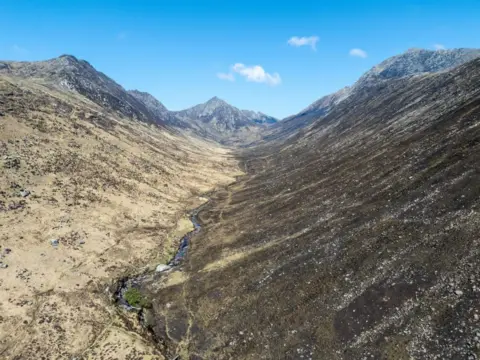
As we walked through the valley, Ms Sampson discovered a live frog and long worm in among the scorched grass.
In the two weeks since the fire, she’s only come across a handful of reptiles still alive.
“It’s hard to know the long-term impacts but the ecology has been totally disrupted and it’s going to take a long time for that to recover,” she said.
What caused the wildfire?
Initial investigations have suggested the fire could have started when dry ground was ignited when sun shone through a discarded glass bottle but the Scottish Fire and Rescue Service (SFRS) has not confirmed a cause.
The SFRS had put a wildfire warning in place covering all of Scotland a week before the Glen Rosa blaze.
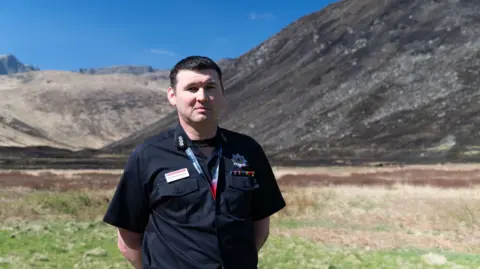
Ricky Donachie, the SFRS station commander for Arran, told the BBC the blaze was classed as a “significant wildfire”.
“Over the wildfire warning period, which lasted from 3 – 9 April, our control rooms received over 5,000 calls,” he said.
“Over 1,000 of them were for grassland and wildfire callouts, with 19 of them in the significant category. It shows the importance of heeding any warnings.”
Mr Donachie warned against lighting fires and barbeques in the countryside.

Despite the devastation to the conservation work in Glen Rosa, Ms Sampson remains positive.
“If we can get it restarted then we might be able to make this land more resilient to fire,” she said.
“If we can establish really good woodlands here, it will not only have great benefits for wildlife and biodiversity but the woodland itself can act as a firebreak.”
Work to replant trees in the Glen Rosa valley has already begun and a fundraising appeal to help revitalise the area has so far raised £12,000.
This weekend, a group of almost 100 volunteers helped plant 6,000 trees.

Beside the beauty spot of the blue pool at Glen Rosa, a shoot from one of the newly-planted trees stands out on the blackened hillside.
“It’s an Arran whitebeam plant.” Ms Sampson says.
“It’s one of the rarest trees in the world and we only have them here on Arran. This can be our first tree of hope.”
